Objective 3. Store Contact and Task Information
A contact is a person or organization, inside or outside your own organization, about whom you can save information such as street and e-mail addresses, telephone and fax numbers, Web page addresses, birthdays, and even pictures. The Contacts component of Outlook is your e-mail address book for storing information about people, organizations, and businesses with which you communicate. The default location for Outlook's Contacts information is the Contacts folder.
In Outlook, a task is a personal or work-related activity that you want to keep track of until it is complete. For example, writing a report, creating a memo, making a sales call, and organizing a staff meeting are all tasks. Use Outlook's Tasks component to create and manage a list of tasks.
Activity 1.8. Creating Contacts
In this activity, you will work with some existing contacts and create new contacts. The existing contacts were imported into your Contacts folder at the same time you imported Darron Jacobsen's messages into your Inbox.
|
|
|
|
1. |
In the Navigation Pane, click Contacts |
|
2. |
On the Standard toolbar, click the New Contact button Figure 1.18. 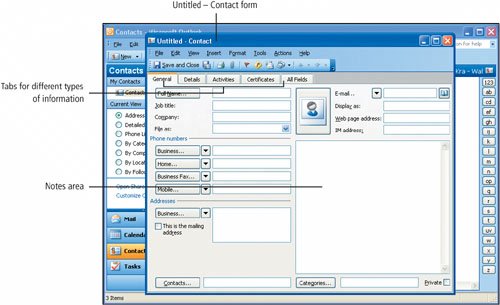
The Untitled - Contact form displays. The form has multiple tabs, including General and Details. Using the space on the various tabs, you can store a variety of information about a person or an organization. A blank area of the form, called the notes area, can be used for any information about the contact that is not otherwise specified in the form. |
|
3. |
In the Untitled - Contact form, in the Full Name box, type James Smith and then press |
|
4. |
In the Job title box, type Vice President, Student Affairs Under Phone numbers, in the Business box, type 312-555-0135 and then press The phone number displays with parentheses around the area code portion of the number. You can also type a phone number without hyphens and Outlook formats it correctly. |
|
5. |
Under Addresses, in the Business box, type the following information, and then compare your screen with Figure 1.19: Figure 1.19. 
More Knowledge: Verifying and Adding Information to Names, Phone Numbers, and Addresses The Contact form contains the Full Name command button and command buttons under Phone numbers and Addresses. These command buttons display dialog boxes that enable you to add more information to a name, phone number, or address. For example, the Full Name command button displays the Check Name dialog box, in which you can add a prefix such as Dr. or Ms. to the contact's name. These dialog boxes also verify the accuracy of the information. Outlook displays these boxes automatically if a name, phone number, or address is incomplete or unclear. |
|
|
|
|
6. |
In the E-mail box, type Jsmith@LakeMichCityCollege.edu and then press Figure 1.20. 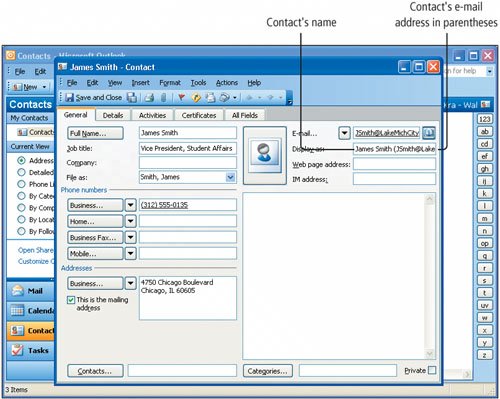
The Display as box shows the contact's name with the e-mail address in parentheses. When you use the contact's address in an e-mail message, this is how Outlook will display the address. Sometimes a contact's e-mail address may be completely unrelated to the person's actual name. When viewing e-mail messages, this feature helps you recall the person associated with the e-mail address. |
|
7. |
Click to place the insertion point in the Display as box, and then press |
|
8. |
On the Contact form toolbar, click the Save and Close button |
|
9. |
On the Standard toolbar, click the New Contact button |
|
|
|
|
10. |
In the Untitled - Contact form, use the technique you just practiced to add the following new contact, using Business for the address and phone information: Figure 1.21. 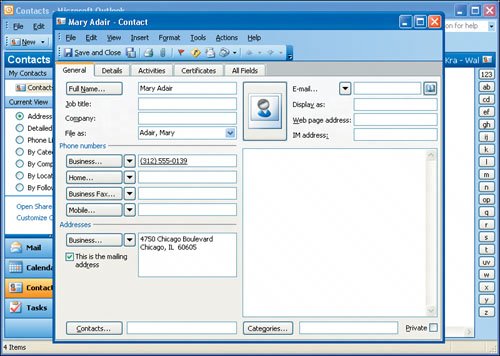
|
|
11. |
On the Contact form toolbar, click the Save and Close button |
|
12. |
In the Navigation Pane, under Current View, click Detailed Address Cards, and then compare your Contacts list with the one displayed in Figure 1.22. Figure 1.22. (This item is displayed on page 88 in the print version) 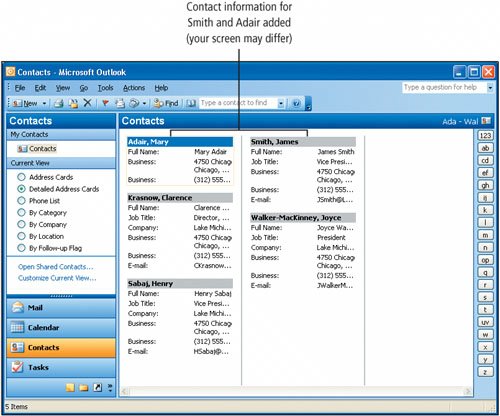
|
The Contacts list displays in Detailed Address Cards view. This view displays more information about individual contacts. Depending on the size of your screen, the arrangement of your contacts may differ from the figure.
Another Way: To Open a Blank Contact Form
You can display a blank Contact form in several ways. In addition to the toolbar button, you can use the keyboard shortcut  . Or, from the File menu, point to New, and then click Contact. Finally, you can right-click in a blank area of the Contacts folder and click New Contact on the shortcut menu. Right-click is the action of clicking an object with the right mouse button; a shortcut menu is a list of context-related commands that displays when you right-click a screen element.
. Or, from the File menu, point to New, and then click Contact. Finally, you can right-click in a blank area of the Contacts folder and click New Contact on the shortcut menu. Right-click is the action of clicking an object with the right mouse button; a shortcut menu is a list of context-related commands that displays when you right-click a screen element.
Activity 1.9. Editing Contacts and Printing the Contacts List
When information about specific contacts changes, you can easily add details, change addresses and phone numbers, or add other information related to the contact. There may be times when you want a printed copy of your Contacts list. For example, if you are taking a business trip, you might want a printed list of the contacts you will be visiting on your trip.
There are different print styles for contacts, depending on what you want to print.
|
1. |
With the Contacts list displayed, point to the contact Mary Adair, and then double-click to open the form. Alternatively, point to the contact, right-click, and from the shortcut menu, click Open. |
|
2. |
In the E-mail box, type MAdair@LakeMichCityCollege.edu and then click Save and Close |
|
3. |
In the Contacts list, use the technique you just practiced to open the Contact form for James Smith. Under Phone numbers, in the Home box, type 312-555-0190 and then Save and Close |
|
4. |
From the File menu, click Print. Under Print style, click the down scroll arrow to view the available print styles. |
|
5. |
Under Print style, click Card Style, and then, in the lower right corner, click Preview. |
|
6. |
Point to the document, click once to increase the magnification, use the bottom and right scroll bars to scroll as necessary, and then compare your screen with Figure 1.23. Figure 1.23. (This item is displayed on page 90 in the print version) 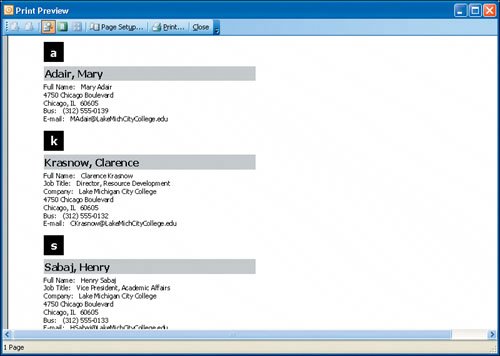
This print style displays the information as it is currently displayed in the Contacts list, which is in the Detailed Address Cards view. Footer information may display at the bottom of the page. |
|
|
|
|
7. |
On the Print Preview toolbar, click the Print button |
|
8. |
In the Print dialog box, in the center of the dialog box, click Page Setup. Under Options, locate the Blank forms at end box. If this box does not display None, click the Blank forms at end arrow, and then click None. |
|
9. |
Click the Header/Footer tab, and delete any existing header or footer information, including dates and page numbers. In the left Footer box, using your own first and last name, type 1A_Contacts_Firstname_Lastname Click OK to redisplay the Print dialog box. |
|
10. |
In the Print dialog box, click Preview to preview the printed document. In the Print Preview window, click Print to return to the Print dialog box, and then click OK to print the entire Contacts list. |
Activity 1.10. Creating and Printing a Tasks List
You can create a new task using a Task form or enter a new task directly in the Tasks list. In this activity, you will create tasks for Darron Jacobsen.
|
1. |
In the Navigation Pane, click the Tasks button Figure 1.24. 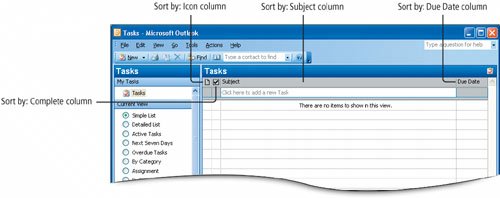
The Tasks list displays and is currently empty. The Navigation Pane for the Tasks folder has the same two-pane structure as the Contacts folder. Individual task items are displayed in a table with column headings for four fields: Icon, Complete, Subject, and Due Date. |
|
2. |
Take a moment to study the main parts of the screen as shown in Figure 1.24. Move the pointer over the four column headings in the Tasks list and observe the ScreenTip for each heading. |
|
3. |
On the Standard toolbar, click the New Task button |
|
4. |
In the Task form, clear the Reminder check box, and then compare your screen to Figure 1.25. Figure 1.25. (This item is displayed on page 92 in the print version) 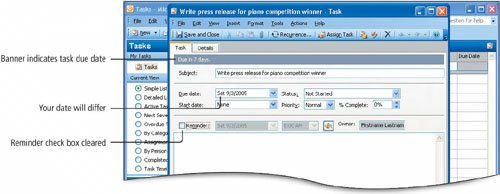
A banner displays at the top of the form indicating the due date. By default, Outlook displays a reminder at 8:00 a.m. on the due date of a task. You must clear this check box if you do not want to be reminded of a task. Alternatively, you can adjust the time of day that you would like to be reminded of a task. The reminder is a small dialog box that displays in the middle of the Outlook screen that is used to remind you of a pending appointment or task. You can work in any Outlook folder when a reminder displays. |
|
|
|
|
5. |
Save and Close |
|
6. |
In the Tasks list under the column headings, click in the Click here to add a new Task box, and then type Work on Joyce's presentation To the right of the Subject text, click in the Due Date box, type Next Thursday and then press |
|
7. |
In the Click here to add a new Task box, type Prepare Mary's performance evaluation In the Due Date box, type Next Monday and press Figure 1.26. 
|
|
8. |
From the File menu, click Print. In the displayed Print dialog box, under Print style, locate the two styles available for tasks. |
|
9. |
In the Print dialog box, click Page Setup. In the Page Setup: Table Style dialog box, click the Header/Footer tab, and then delete any existing header or footer information, including dates and page numbers. In the left Footer box and using your own name, type 1A_Tasks_Firstname_Lastname In the lower right corner of the dialog box, click Print. In the Print dialog box, click Preview to preview the printed document. In the Print Preview window, click Print to return to the Print dialog box, and then click OK to print the Tasks list. |
|
[Page 93 (continued)] Objective 4 Work with the Calendar |
Windows XP
- Chapter One. Getting Started with Windows XP
- Project 1A. Windows XP
- Objective 1. Get Started with Windows XP
- Objective 2. Resize, Move, and Scroll Windows
- Objective 3. Maximize, Restore, Minimize, and Close a Window
- Objective 4. Create a New Folder
- Objective 5. Copy, Move, Rename, and Delete Files
- Objective 6. Find Files and Folders
- Objective 7. Compress Files
- Summary
- Key Terms
- Concepts Assessments
Outlook 2003
- Chapter One. Getting Started with Outlook 2003
- Getting Started with Microsoft Office Outlook 2003
- Project 1A. Exploring Outlook 2003
- Objective 1. Start and Navigate Outlook
- Objective 2. Read and Respond to E-mail
- Objective 3. Store Contact and Task Information
- Objective 4. Work with the Calendar
- Objective 5. Delete Outlook Information and Close Outlook
- Summary
- Key Terms
- Concepts Assessments
- Skill Assessments
- Performance Assessments
- Mastery Assessments
- Problem Solving
- GO! with Help
Internet Explorer
- Chapter One. Getting Started with Internet Explorer
- Getting Started with Internet Explorer 6.0
- Project 1A. College and Career Information
- Objective 1. Start Internet Explorer and Identify Screen Elements
- Objective 2. Navigate the Internet
- Objective 3. Create and Manage Favorites
- Objective 4. Search the Internet
- Objective 5. Save and Print Web Pages
- Summary
- Key Terms
- Concepts Assessments
- Skill Assessments
- Performance Assessments
- Mastery Assessments
- Problem Solving
Computer Concepts
- Chapter One. Basic Computer Concepts
- Objective 1. Define Computer and Identify the Four Basic Computing Functions
- Objective 2. Identify the Different Types of Computers
- Objective 3. Describe Hardware Devices and Their Uses
- Objective 4. Identify Types of Software and Their Uses
- Objective 5. Describe Networks and Define Network Terms
- Objective 6. Identify Safe Computing Practices
- Summary
- In this Chapter You Learned How to
- Key Terms
- Concepts Assessments
Word 2003
Chapter One. Creating Documents with Microsoft Word 2003
- Chapter One. Creating Documents with Microsoft Word 2003
- Getting Started with Microsoft Office Word 2003
- Project 1A. Thank You Letter
- Objective 1. Create and Save a New Document
- Objective 2. Edit Text
- Objective 3. Select, Delete, and Format Text
- Objective 4. Create Footers and Print Documents
- Project 1B. Party Themes
- Objective 5. Navigate the Word Window
- Objective 6. Add a Graphic to a Document
- Objective 7. Use the Spelling and Grammar Checker
- Objective 8. Preview and Print Documents, Close a Document, and Close Word
- Objective 9. Use the Microsoft Help System
- Summary
- Key Terms
- Concepts Assessments
- Skill Assessments
- Performance Assessments
- Mastery Assessments
- Problem Solving
- You and GO!
- Business Running Case
- GO! with Help
Chapter Two. Formatting and Organizing Text
- Formatting and Organizing Text
- Project 2A. Alaska Trip
- Objective 1. Change Document and Paragraph Layout
- Objective 2. Change and Reorganize Text
- Objective 3. Create and Modify Lists
- Project 2B. Research Paper
- Objective 4. Insert and Format Headers and Footers
- Objective 5. Insert Frequently Used Text
- Objective 6. Insert and Format References
- Summary
- Key Terms
- Concepts Assessments
- Skill Assessments
- Performance Assessments
- Mastery Assessments
- Problem Solving
- You and GO!
- Business Running Case
- GO! with Help
Chapter Three. Using Graphics and Tables
- Using Graphics and Tables
- Project 3A. Job Opportunities
- Objective 1. Insert and Modify Clip Art and Pictures
- Objective 2. Use the Drawing Toolbar
- Project 3B. Park Changes
- Objective 3. Set Tab Stops
- Objective 4. Create a Table
- Objective 5. Format a Table
- Objective 6. Create a Table from Existing Text
- Summary
- Key Terms
- Concepts Assessments
- Skill Assessments
- Performance Assessments
- Mastery Assessments
- Problem Solving
- You and GO!
- Business Running Case
- GO! with Help
Chapter Four. Using Special Document Formats, Columns, and Mail Merge
- Using Special Document Formats, Columns, and Mail Merge
- Project 4A. Garden Newsletter
- Objective 1. Create a Decorative Title
- Objective 2. Create Multicolumn Documents
- Objective 3. Add Special Paragraph Formatting
- Objective 4. Use Special Character Formats
- Project 4B. Water Matters
- Objective 5. Insert Hyperlinks
- Objective 6. Preview and Save a Document as a Web Page
- Project 4C. Recreation Ideas
- Objective 7. Locate Supporting Information
- Objective 8. Find Objects with the Select Browse Object Button
- Project 4D. Mailing Labels
- Objective 9. Create Labels Using the Mail Merge Wizard
- Summary
- Key Terms
- Concepts Assessments
- Skill Assessments
- Performance Assessments
- Mastery Assessments
- Problem Solving
- You and GO!
- Business Running Case
- GO! with Help
Excel 2003
Chapter One. Creating a Worksheet and Charting Data
- Creating a Worksheet and Charting Data
- Project 1A. Tableware
- Objective 1. Start Excel and Navigate a Workbook
- Objective 2. Select Parts of a Worksheet
- Objective 3. Enter and Edit Data in a Worksheet
- Objective 4. Construct a Formula and Use the Sum Function
- Objective 5. Format Data and Cells
- Objective 6. Chart Data
- Objective 7. Annotate a Chart
- Objective 8. Prepare a Worksheet for Printing
- Objective 9. Use the Excel Help System
- Project 1B. Gas Usage
- Objective 10. Open and Save an Existing Workbook
- Objective 11. Navigate and Rename Worksheets
- Objective 12. Enter Dates and Clear Formats
- Objective 13. Use a Summary Sheet
- Objective 14. Format Worksheets in a Workbook
- Summary
- Key Terms
- Concepts Assessments
- Skill Assessments
- Performance Assessments
- Mastery Assessments
- Problem Solving
- You and GO!
- Business Running Case
- GO! with Help
Chapter Two. Designing Effective Worksheets
- Designing Effective Worksheets
- Project 2A. Staff Schedule
- Objective 1. Use AutoFill to Fill a Pattern of Column and Row Titles
- Objective 2. Copy Text Using the Fill Handle
- Objective 3. Use AutoFormat
- Objective 4. View, Scroll, and Print Large Worksheets
- Project 2B. Inventory Value
- Objective 5. Design a Worksheet
- Objective 6. Copy Formulas
- Objective 7. Format Percents, Move Formulas, and Wrap Text
- Objective 8. Make Comparisons Using a Pie Chart
- Objective 9. Print a Chart on a Separate Worksheet
- Project 2C. Population Growth
- Objective 10. Design a Worksheet for What-If Analysis
- Objective 11. Perform What-If Analysis
- Objective 12. Compare Data with a Line Chart
- Summary
- Key Terms
- Concepts Assessments
- Skill Assessments
- Performance Assessments
- Mastery Assessments
- Problem Solving
- You and GO!
- Business Running Case
- GO! with Help
Chapter Three. Using Functions and Data Tables
- Using Functions and Data Tables
- Project 3A. Geography Lecture
- Objective 1. Use SUM, AVERAGE, MIN, and MAX Functions
- Objective 2. Use a Chart to Make Comparisons
- Project 3B. Lab Supervisors
- Objective 3. Use COUNTIF and IF Functions, and Apply Conditional Formatting
- Objective 4. Use a Date Function
- Project 3C. Loan Payment
- Objective 5. Use Financial Functions
- Objective 6. Use Goal Seek
- Objective 7. Create a Data Table
- Summary
- Key Terms
- Concepts Assessments
- Skill Assessments
- Performance Assessments
- Mastery Assessments
- Problem Solving
- You and GO!
- Business Running Case
- GO! with Help
Access 2003
Chapter One. Getting Started with Access Databases and Tables
- Getting Started with Access Databases and Tables
- Project 1A. Academic Departments
- Objective 1. Rename a Database
- Objective 2. Start Access, Open an Existing Database, and View Database Objects
- Project 1B. Fundraising
- Objective 3. Create a New Database
- Objective 4. Create a New Table
- Objective 5. Add Records to a Table
- Objective 6. Modify the Table Design
- Objective 7. Create Table Relationships
- Objective 8. Find and Edit Records in a Table
- Objective 9. Print a Table
- Objective 10. Close and Save a Database
- Objective 11. Use the Access Help System
- Summary
- Key Terms
- Concepts Assessments
- Skill Assessments
- Performance Assessments
- Mastery Assessments
- Problem Solving Assessments
- Problem Solving
- You and GO!
- Business Running Case
- GO! with Help
Chapter Two. Sort, Filter, and Query a Database
- Sort, Filter, and Query a Database
- Project 2A. Club Fundraiser
- Objective 1. Sort Records
- Objective 2. Filter Records
- Objective 3. Create a Select Query
- Objective 4. Open and Edit an Existing Query
- Objective 5. Sort Data in a Query
- Objective 6. Specify Text Criteria in a Query
- Objective 7. Print a Query
- Objective 8. Specify Numeric Criteria in a Query
- Objective 9. Use Compound Criteria
- Objective 10. Create a Query Based on More Than One Table
- Objective 11. Use Wildcards in a Query
- Objective 12. Use Calculated Fields in a Query
- Objective 13. Group Data and Calculate Statistics in a Query
- Summary
- Key Terms
- Concepts Assessments
- Skill Assessments
- Performance Assessments
- Mastery Assessments
- Problem Solving
- You and GO!
- Business Running Case
- GO! with Access Help
Chapter Three. Forms and Reports
- Forms and Reports
- Project 3A. Fundraiser
- Objective 1. Create an AutoForm
- Objective 2. Use a Form to Add and Delete Records
- Objective 3. Create a Form Using the Form Wizard
- Objective 4. Modify a Form
- Objective 5. Create an AutoReport
- Objective 6. Create a Report Using the Report Wizard
- Objective 7. Modify the Design of a Report
- Objective 8. Print a Report and Keep Data Together
- Summary
- Key Terms
- Concepts Assessments
- Skill Assessments
- Performance Assessments
- Mastery Assessments
- Problem Solving
- You and GO!
- Business Running Case
- GO! with Help
Powerpoint 2003
Chapter One. Getting Started with PowerPoint 2003
- Getting Started with PowerPoint 2003
- Project 1A. Expansion
- Objective 1. Start and Exit PowerPoint
- Objective 2. Edit a Presentation Using the Outline/Slides Pane
- Objective 3. Format and Edit a Presentation Using the Slide Pane
- Objective 4. View and Edit a Presentation in Slide Sorter View
- Objective 5. View a Slide Show
- Objective 6. Create Headers and Footers
- Objective 7. Print a Presentation
- Objective 8. Use PowerPoint Help
- Summary
- Key Terms
- Concepts Assessments
- Skill Assessments
- Performance Assessments
- Mastery Assessments
- Problem Solving
- You and GO!
- Business Running Case
- GO! with Help
Chapter Two. Creating a Presentation
- Creating a Presentation
- Project 2A. Teenagers
- Objective 1. Create a Presentation
- Objective 2. Modify Slides
- Project 2B. History
- Objective 3. Create a Presentation Using a Design Template
- Objective 4. Import Text from Word
- Objective 5. Move and Copy Text
- Summary
- Key Terms
- Concepts Assessments
- Skill Assessments
- Performance Assessments
- Mastery Assessments
- Problem Solving
- You and GO!
- Business Running Case
- GO! with Help
Chapter Three. Formatting a Presentation
- Project 3A. Emergency
- Objective 1. Format Slide Text
- Objective 2. Modify Placeholders
- Objective 3. Modify Slide Master Elements
- Objective 4. Insert Clip Art
- Project 3B. Volunteers
- Objective 5. Apply Bullets and Numbering
- Objective 6. Customize a Color Scheme
- Objective 7. Modify the Slide Background
- Objective 8. Apply an Animation Scheme
- Summary
- Key Terms
- Concepts Assessments
- Skill Assessments
- Performance Assessments
- Mastery Assessments
- Problem Solving
- You and GO!
- Business Running Case
- GO! with Help
Integrated Projects
Chapter One. Using Access Data with Other Office Applications
- Chapter One. Using Access Data with Other Office Applications
- Introduction
- Project 1A. Meeting Slides
- Objective 1. Export Access Data to Excel
- Objective 2. Create a Formula in Excel
- Objective 3. Create a Chart in Excel
- Objective 4. Copy Access Data into a Word Document
- Objective 5. Copy Excel Data into a Word Document
- Objective 6. Insert an Excel Chart into a PowerPoint Presentation
Chapter Two. Using Tables in Word and Excel
- Chapter Two. Using Tables in Word and Excel
- Introduction
- Project 2A. Meeting Notes
- Objective 1. Plan a Table in Word
- Objective 2. Enter Data and Format a Table in Word
- Objective 3. Create a Table in Word from Excel Data
- Objective 4. Create Excel Worksheet Data from a Word Table
Chapter Three. Using Excel as a Data Source in a Mail Merge
- Chapter Three. Using Excel as a Data Source in a Mail Merge
- Introduction
- Project 3A. Mailing Labels
- Objective 1. Prepare a Mail Merge Document as Mailing Labels
- Objective 2. Choose an Excel Worksheet as a Data Source
- Objective 3. Produce and Save Merged Mailing Labels
- Objective 4. Open a Saved Main Document for Mail Merge
Chapter Four. Linking Data in Office Documents
- Chapter Four. Linking Data in Office Documents
- Introduction
- Project 4A. Weekly Sales
- Objective 1. Insert and Link in Word an Excel Object
- Objective 2. Format an Object in Word
- Objective 3. Open a Word Document That Includes a Linked Object, and Update Links
Chapter Five. Creating Presentation Content from Office Documents
EAN: 2147483647
Pages: 448
 to display the Contacts folder.
to display the Contacts folder. , and then compare your screen with Figure 1.18.
, and then compare your screen with Figure 1.18. .
. as necessary to view the entire address.
as necessary to view the entire address. .
. to redisplay the Print dialog box.
to redisplay the Print dialog box. to display the Tasks folder. Compare your screen with Figure 1.24.
to display the Tasks folder. Compare your screen with Figure 1.24. . In the Untitled - Task form, in the Subject box, type Write press release for piano competition winner Click the Due date arrow. On the displayed calendar, click a date one week from the current date.
. In the Untitled - Task form, in the Subject box, type Write press release for piano competition winner Click the Due date arrow. On the displayed calendar, click a date one week from the current date. .
.